Excerpts from Jim Conrad's
Naturalist Newsletter
from the September 1, 2008 Newsletter written in Sabacché, western Yucatán, MÉXICO
WILD YAMS FLOWERING
Out in the scrub you see lots of wiry-stemmed vines with heart-shaped leaves climbing other plants as seen below:
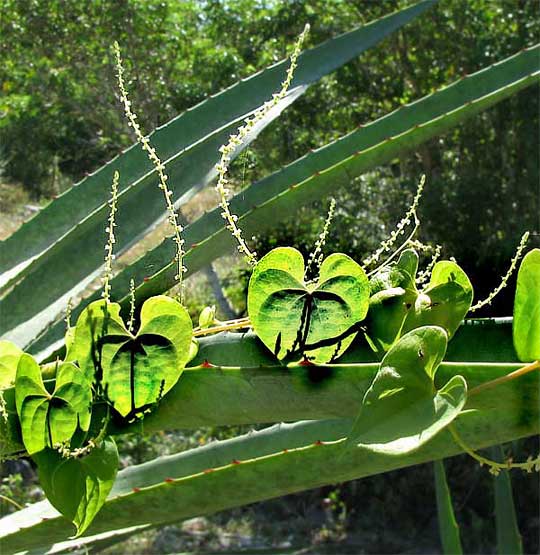
In that picture it's clear I'm not talking about morning-glories, which are often vines with heart- shaped leaves arising from wiry stems, for the flowers are definitely not morning-glory-like. Anyone familiar with Temperate Zone plants will recognize the vine as a wild yam, genus Dioscorea.
One distinguishing feature of Dioscoreas is that their leaves have several strong veins arising at the point of petiole attachment and fanning out. Moreover, other veins connecting the strong veins form vaguely rectangular cells. In most leaves cells formed by reticulating secondary veins are irregular in shape. Dioscorea's somewhat rectangular cells create a "ladder effect" between the strong veins, as seen below:
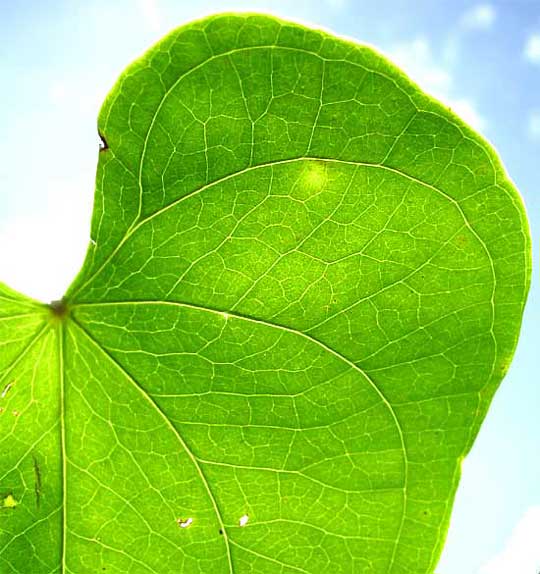
The slender flower spikes arising all along the stem in the first picture also are distinctive for Dioscorea. If you look closely at one of the tiny, widely spaced blossoms in a spike you see that it's a neat little flower with six greenish-yellow, petal-like lobes, three stamens with pollen-producing anthers, but no female parts -- no pistil consisting of stigma, style and ovary. In fact, the tiny flowers in the slender spikes of the first picture are all male flowers, for this species puts its male and female flowers on separate plants -- it is dioecious.
I had to search awhile before finding a female plant, and I have no idea why female plants should be so hard to find. You can see the very different female flowers below:
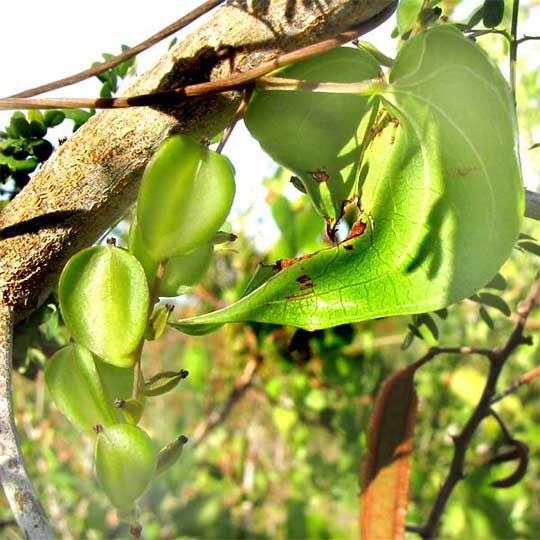
In that picture the female flowers are the three-winged, thumbnail-sized, Chinese-lantern affairs on the left. Each developing ovary is topped by three stubby, brown styles with stigmas.
In Eastern North America after the first frost you often see handsome chains of similar-shaped but mature and straw-colored fruits dangling from bushes, blowing in cold, early-winter wind. These are produced by Dioscorea villosa, also called Wild Yam.
The "yam" part of the name refers to the edible tubers produced by many Dioscorea species. I've always found North America's Wild Yam tubers too small, hard and fibrous to fool with, and from what I can feel with my finger around stem bases of plants here here, it's about the same with this species. However, I'll bet that either species grown in rich, loose garden soil and well nourished might produce something savory and nutritious.
Dioscoreas are unusual enough to have their own plant family, the Wild Yam Family, the Dioscoreaceae. Sometimes sweet potatoes are referred to as yams, but of course they're something else entirely, members of the Morning-Glory Family. The genus Dioscorea was named after Dioscorides, a Greek physician and naturalist of classical times.
from the February 14, 2010 Newsletter issued from Hacienda Chichen Resort beside Chichén Itzá Ruins, central Yucatán, MÉXICO; limestone bedrock, elevation ~39m (~128ft), ~N20.676°, ~W88.569°
WILD YAM AND ITS "SIGN"
Deep in the forest in the zone where I would guess about ten acres of unexcavated Maya ruins reveal themselves as no more than systematically arrayed, massive, ten-ft-high heaps of squared limestone rocks sometimes bearing hieroglyphics, my attention was drawn to a recent digging -- not by looters as too often is the case but by some critter such as a fox going after a meal in its burrow. I don't know if the digger got his meal but he did unearth what's shown below:
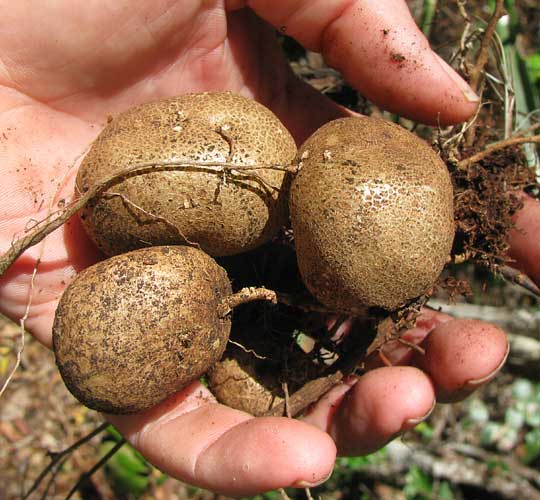
These are much like the wild yams I'm accustomed to in the US Southeast, but much, much larger. Wild Yams are slender vines bearing unisexual flowers and often, but not always, underground, potato-like tubers. In 2008 from Sabacché in the Yucatán I showed the male and female flowers of a wild yam species. That report is shown above.
I wanted to confirm that this was a Dioscorea. The vine leading from the disinterred tubers had long blackened and disintegrated, but maybe I could find the old, dead vine twining up a nearby tree. What I found was the living tip of an otherwise dead and rotting vine, the tip bearing a tiny, immature leaf the size of a little girl's fingernail. It's shown below:
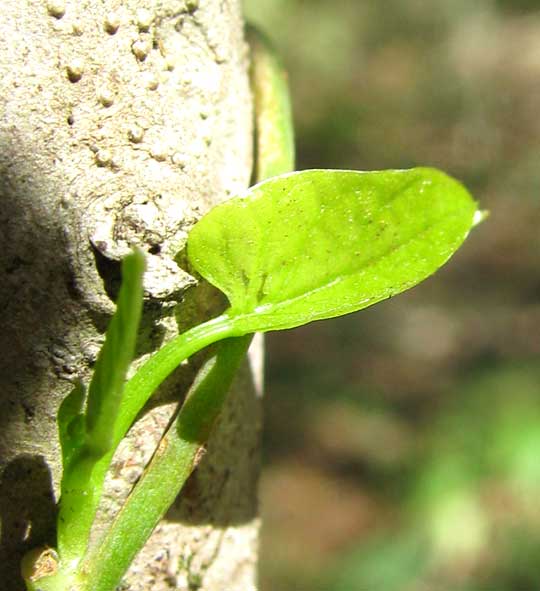
Is that a Dioscorea leaf? It's heartshaped like most Dioscorea leaves I know, plus, if you look closely you can see that the crossveins connecting the leaf's secondary veins are somewhat parallel to one another, forming rectangular cells. The way this appears on a mature leaf is shown on the above Sabacché page.
Wild Yams are members of the Wild Yam Family, the Dioscoreaceae, and the genus Dioscorea. I doubt that the Dioscorea species shown at the above link is the same species producing the big tubers in my hand, for people in Sabacché told me that their plants didn't produce tubers. Several Dioscorea species are listed for the Yucatán but descriptions aren't given. Maybe it's Dioscorea floribunda.
The local Maya certainly are familiar with the tubers, calling them Tsekél. One fellow said they were found beneath rocks, and that makes sense, for the soil here is so rocky that if any plant is going to have big tubers it'll have to sprout between rocks, but put its tubers under the rocks.
Maximino Martínez's Las Plantas Medicinales de México has a lot to say about Dioscorea tubers, for they contain the chemical diosgenin, which in the laboratory can be made into various steroids, such as estrogen and DHEA. Traditionally Mexico's Dioscoreas have been used for arthritis, rheumatic fever, and various general pains.
While I held the yams in my hand I stood thinking how fine it would be if I were sharp enough to have found the tubers by having first spotted the tiny leaf and the rotting, twining vine below it, instead of having to see the tubers themselves. I think our distant ancestors had that power -- the power to find "signs" of foods that otherwise lay hidden.